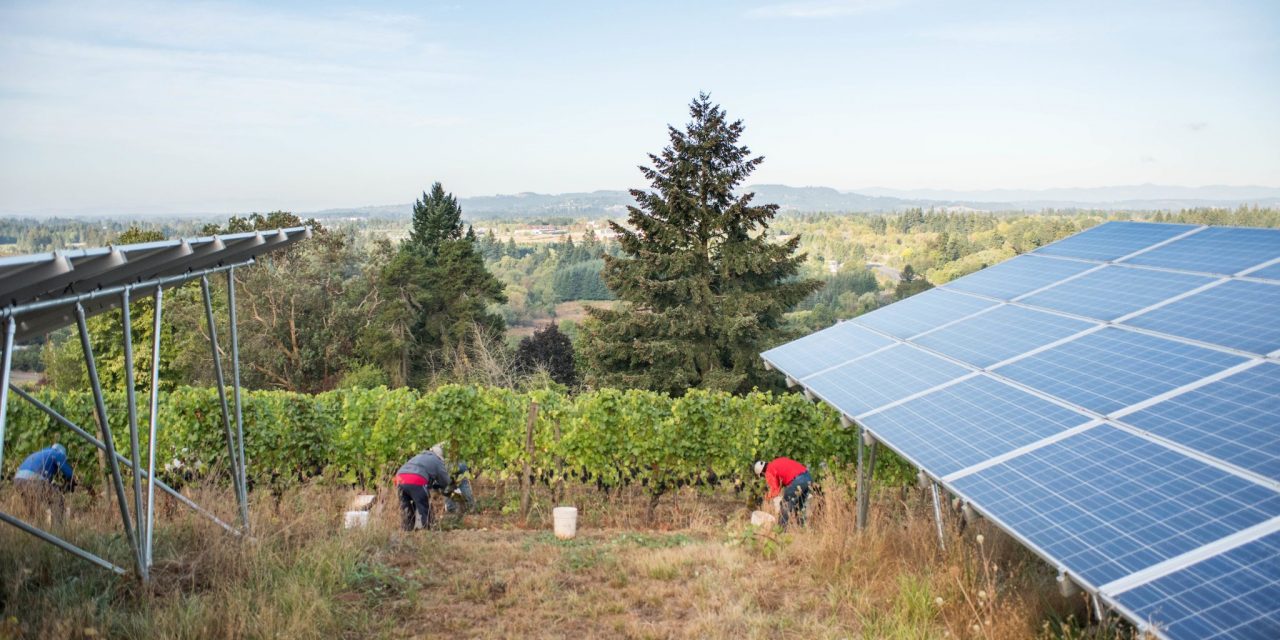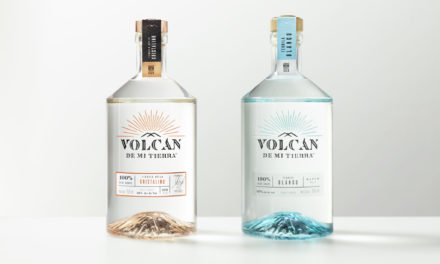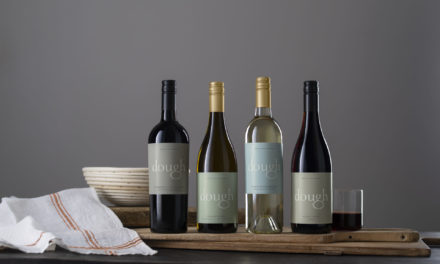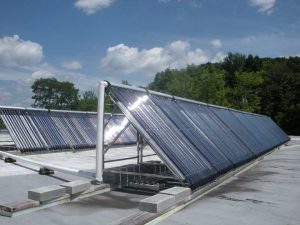
A solar array at Sundog Cider
Alternative energy isn’t just piece of New York’s Sundog Ciders’ story—it’s more or less the company’s reason for being. In 2004, when Sundog Solar in the Hudson River Valley (127 miles north of New York City) began installing panels for homes and businesses, many of its customers were the family-owned apple orchards that dot the valley. In 2014, Sundog owner Jody Rael decided to pursue his long-time interest by setting up a cidery in the solar company facility. Since the building had been converted from a paper mill and had already updated with solar panels for electricity, solar setups for hot water and air conditioning, and a heating system that runs on used vegetable oil, Sundog didn’t need to worry about energy efficiency.
“When people come to the cidery for a tasting, I tell them about what we’ve done,” says Betsy Wyman, Sundog’s vice president, “and they leave not just knowing about our cider, but saying they want to install solar.”

Montanya Rum owner Karen Hoskin teaches sustainability seminars at trade shows and industry events.
Sundog isn’t alone. A variety of small producers, from cider to beer to spirits to wine, have embraced alternative energy in diverse and sometimes surprising ways. It’s one thing when a company that’s part of Big Wine or Big Beer goes green, given the almost unlimited resources that can be made available for the project. But when small producers like Sundog or Montanya Rum (in Colorado’s Gunnison Valley) do it, it speaks volumes about commitment. That’s a lot of time, expense, and effort for companies where cash flow is paramount and there’s no excess of employees to handle the paperwork and bureaucracy that goes hand-in-hand with installing something like solar panels.
But they do it anyway.
“If you look at what we do, whether we’re a winery, brewery, or a spirits producer, we’re pioneers,” says Harry Peterson-Nedry, founder of Chehalem Winery in Oregon’s Willamette Valley, where five solar arrays generate as much as 40 percent of the electricity. “We look at how we do business differently, and that means we don’t mind being pioneers in something like alternative energy.”
Green overview
Green energy—power sources like wind, solar, and geothermal—accounted for just 6.4 percent of the electricity generated in the United States in 2016, according to an estimate from the federal Energy Information Administration. The most common renewable energy source, hydro (aka water), isn’t an option in most of the country, and it’s usually rolled into the overall grid in those regions where it does generate power.
That means fossil fuels, mostly coal and natural gas, still generate about two-thirds of the electricity used in the nation. This preponderance of traditional fuel delivered in the traditional way comes despite vast improvements in generating, delivering, and maintaining green power—especially solar—as well as more widespread acceptance of using alternative energy. It’s also different from the idea of sustainability, which is more about practices and processes throughout an entire operation, from more efficient water use to best building practices, which can include green energy but doesn’t have to.

Leah and brock Ashburn, founders of Highland Brewing Company
For many independent companies, making a move to alternative energy needs to be part of a larger long-term plan to make it feasible. “We had to replace the roof and our switchgear,” says Brock Ashburn, vice president of operations, engineer and general contractor for the 46,000-barrel Highland Brewing Company in Asheville, N.C. “This fact, along with state and federal incentives, a desire to reduce our carbon footprint, and ample roof area made solar a viable option for us. The installation wasn’t without frustration, but overall, it wasn’t as much trouble as we thought it was going to be.”
Why do so many small producers choose this path? The answer lies in what they do and why they do it. “I’m a total freak about reducing carbon emissions,” says Montanya owner Karen Hoskin, who teaches sustainability seminars at trade shows and industry events on a regular basis. “I’m always looking for ways to do whatever I can, whether it’s on or off the grid, to reduce and offset the carbon we and our supplies emit. It’s really about a sense of moral obligation.”
That’s because, as the University of Washington’s James McWilliams writes, craft beer—and, by extension, craft spirits, cider, and small wine—is a social business, where the owners know their customers in a way large companies don’t. Customers aren’t merely figures on a spreadsheet but, instead, individuals who come into the tasting room with some frequency. Small producers need to worry about what the person in the tasting room thinks about the business; otherwise, those visitors won’t keep coming in.
On the green end

Chehalem Winery founder Harry Peterson-Nedry
Using alternative energy revolves around not just social and moral principles, but also marketing and the bottom line. First, since not every producer starts with a solar company as one of its businesses, the decision to install solar or wind energy systems comes down to cost: Does it make sense for the bottom line?
Many times it does, thanks to federal law that requires a local utility to buy excess energy its customers generate. The actual process is much more complicated, of course, but the result is often money in the business’ pocket over a decade or more. Some days, a winery won’t use all the electricity it generates and will be able to sell the excess. That could be a substantial amount, given the reduced amount of energy necessary to run a winery, brewery, distillery, or cidery when it’s not in production, for example. Often, that turns into a check from the utility, something many producers say is as welcome as it used to be unexpected. In other months, when the business requires more power (or the sun isn’t shining or the wind isn’t blowing), it can still buy what it needs from the grid like any other customer.
Chehalem, for example, signed a 15-year contract with its utility provider that set rates and prices for the winery to buy and sell energy. In Chehalem’s case, this means four to eight years to repay on the cost of its investment, plus what Peterson-Nedry calls a substantial return over 30 years in reduced electricity costs. One way to look at it, he says, is that Chehalem not only makes wine, it also generates electricity.
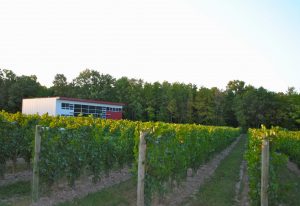
Red Tail Ridge Winery uses geothermal energy for its heating and cooling systems, and to power tank refrigeration. [Photo courtesy Red Tail Ridge]
Comparisons and measurements can be difficult in these situations, but the businesses interviewed for this article said alternative energy often supplied much, if not all, their needs. At Sundog, its various solar and other alternative energy systems provide almost all the electricity and hot water the cidery uses, and it’s cut costs 85 to 90 percent. Ashburn says on sunny days, Highland’s solar setup, the third largest for a craft brewery in the United States, produces more power than it can use, including administration, guest services, and brewing operations; overall solar offsets a substantial amount of what it needs to power the business. The geothermal system at the Red Tail Ridge Winery in New York’s Finger Lakes converts the earth’s heat to electricity for the winery’s heating and cooling systems and to power tank refrigeration—and it paid for itself in 2.5 years after its 2009 installation.
“It was easier for us to make a commitment to sustainability because we’re a small company,” says Danielle DiDuro, who oversees the tasting room, marketing, and sales for the 8,500-case Red Tail Ridge. “We don’t have a board of directors to convince—there are less hands involved with the business.”
One other key: Finding an installer, regardless of alternative energy system, who understands the process—the permits required, whether there are special zoning requirements, how much space is required to build a big enough system, and even return on investment criteria. That will make the job that much easier, said several producers.
Perhaps the most surprising thing about building green systems is that lenders don’t necessarily object. Yes, there are state and federal tax credits, grants, and loans, and these play key roles in paying to go green. Chehalem secured a $20,000 government grant, while Highland combined state and federal incentives to build its system.
But in the end, lenders—be it a bank or farm credit service—need to provide the bulk of construction and installation money. And, mostly (or as “mostly” as you can say for a lender), they seem to like the idea.
“They see it as just another cost of doing business,” says Hoskin, who uses a solar wall in her barrel room to fluctuate temperatures naturally, is designing a full photovoltaic array for the roof of her warehouse, and buys Colorado wind power for 100 percent of her facilities’ current electricity use. In this, she’s not alone.
Ashburn says his bank was “fairly comfortable” with lending money for solar, while the growth in industry-specific lenders who better understand how a small producer works, like wine’s Silicon Valley Bank, has helped, too, says Peterson-Nedry.

Montanya Rum operates its entire facility using Colorado wind power from Acadia Power. [Photo courtesy Montanya Rum]
The first assumption many make is that customers want their alcohol to be “green,” whether sustainable, organic, or made with alternative energy. The truth appears to be much more complicated.
“It was a process of educating people,” says DiDuro, whose labels initially had information about the winery’s geothermal systems. “We had to make consumers understand what we were doing and why we were doing it. Only then did what we were doing gain value. Now, they expect us to impact the environment as little as possible.”
The Red Tail Ridge experience isn’t unique. In many surveys, there’s a sense consumers don’t rate green practices as highly as they do cost and quality. In the 2016 Survey of American Wine Consumer Preferences, conducted by Sonoma State University in California, the bottom three reasons for purchase were whether wines were organic, sustainable, or biodynamic. Even producers who’ve built their brand around “green” have seen this—but there’s a sense this is changing, says Hoskin.
“Our green marketing at Montanya didn’t resonate with our customers when we started in 2008,” she says. “But we felt a shift—and I saw a similar shift in society over time—as more people became interested in transparency and eco-sustainability. There’s much more appeal to people now, how you run your business—and it can even extend to things like genetically engineered corn.” Hoskin carefully chooses ingredients to avoid GMOs. Which, in the end, benefits both companies and their customers—and isn’t that what the best producers, big or small, should be doing?
(Click here for tasting notes related to this article)

